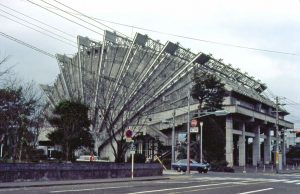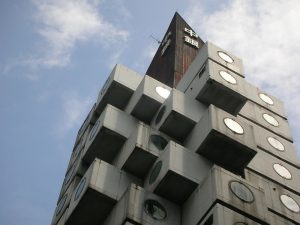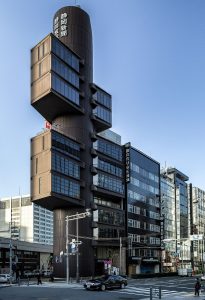Japanese Metabolism Architecture
Metabolism is an architectural style that emerged in post-war Japan. In a country recovering from the devastating effects of World War II, not least the atomic bomb and the huge loss of life, Metabolism represented hope for the future and exciting rebuilding opportunities.
Subsequently, at the 1960 World Design Conference, four Japanese architects revealed their Metabolist Manifesto, challenging Western ideas of static buildings and instead bringing together the concepts of man-made structures and biological growth.

Cultural Center in Miyakonoyo, 1966 by Kiyonori Kikutake. Bigjap / CC0
At its crux, Metabolism states that architecture should be organic and respond to society and its disasters, both natural and artificial. Perhaps the best example of Metabolist Architecture is Tokyo’s Capsule Tower.
Based on the Metabolist principle that cities and buildings are ever-changing and organic, Metabolist architecture is built to be adapted, changed and replaced as the needs of society evolve. This means that they are designed to accommodate population growth, changing demographics and natural or human disasters.

FUN FACT: Logan and Markio check into this building (Tokyo’s Capsule Tower) in The Wolverine. Photo by Forgemind ArchiMedia | Flickr
A key feature of Japanese Metabolism is thus modular structures, with a ‘spine-like’ core and pre-made parts which can be easily removed and attached as desired. They are often quite simplistic in shape and colour, with an organic feel. The result is a uniquely modern look, even futuristic.Perhaps unsurprisingly, the most famous Metabolist architects are the founders of the movement, Kiyonori Kikutake, Kisho Kurokawa and Fumihiko Maki. Their innovative and daring designs ranged from floating cities to capsule towers.
While many were only concepts and never physically realised, their philosophy of organic cities was revolutionary and challenged the way we see architecture today. Similarly innovative in the online gaming world, King Billy casino offers a cutting-edge, user-friendly platform with a wide variety of games, enhancing the player’s experience.

Shizuoka Press and Broadcasting Center by architect Kenzo Tange. Jonathan Savoie / CC
Cover Photo By S23725 / CC BY-SA





